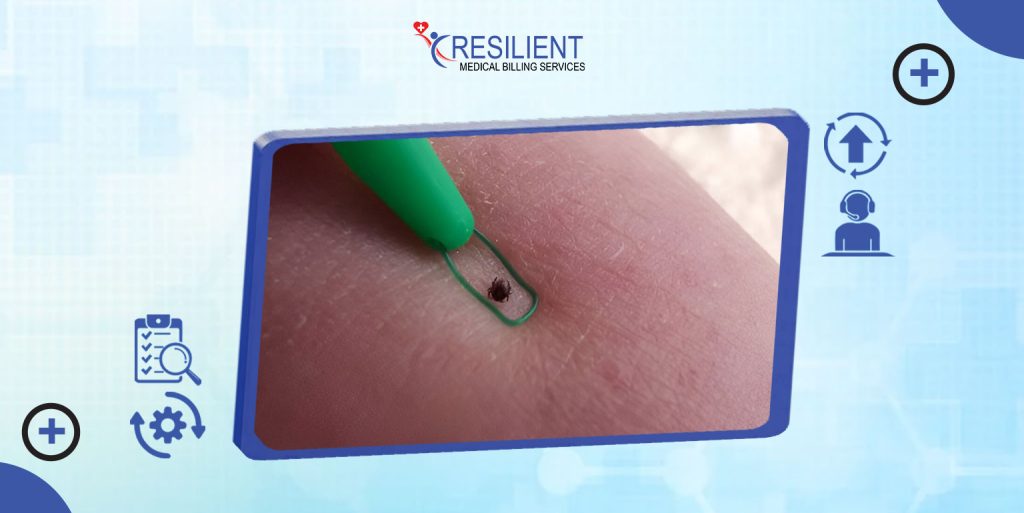Medical coding is more than just a formality. It’s essential for providing good treatment. Choosing the right ICD 10 codes for tick removal is crucial for accurate documentation, expedited insurance payments, and streamlined billing.
Proper coding enables providers to focus on patient care while maintaining financial stability. In this blog, we are going to discuss the importance of accurate coding for tick removal and how to apply the proper ICD 10 tick bite codes to ensure compliance and efficient reimbursement.
Understanding Tick Removal in Medical Coding
Tick removal is a commonly performed medical procedure aimed at safely extracting a tick embedded in a patient’s skin. This intervention is necessary to prevent potential complications that may arise from tick bites, such as infections or transmission of diseases like Lyme disease.
In clinical practice, tick removal is performed when a patient has a recent tick bite or there is concern about disease transmission. The procedure requires careful extraction to avoid tissue damage and infection.
Tick bites may cause redness, itching, swelling, or systemic symptoms if infected. Accurate recognition and documentation are crucial for correct diagnosis and effective treatment. Medical coders use specific ICD-10 codes for tick bites to record these details in patient records.
ICD-10 Codes for Tick Removal and Tick Bites
When coding for tick removal, healthcare providers primarily rely on specific ICD-10 codes that capture the nature of the encounter, including the removal procedure and any complications from the tick bite.
Primary ICD-10 Code(s) for Tick Removal:
Z54.89 — Other surgical aftercare (used in cases involving post-procedural care, including tick removal complications)
T63.42XA — Toxic effect of contact with tick, initial encounter
T63.42XD — Toxic effect of contact with tick, subsequent encounter
T63.42XS — Toxic effect of contact with tick, sequela
Most often, the focus is on identifying the consequences or complications of a tick bite, rather than removal, unless further treatment is necessary.
Explanation of Commonly Used Codes for Billing:
T63.42XA is used for initial encounters when symptoms arise from a tick bite. If removal is uncomplicated and no further treatment is required, providers use a code that matches the encounter type (e.g., routine removal during a physical examination).
T63 codes are usually combined with external cause codes to detail the injury or exposure context.
Detailed Look at Tick Bite ICD 10 Codes
The ICD-10 system differentiates between various presentations and complications of tick bites to facilitate accurate coding and billing.

Breakdown of Specific ICD 10 Code for Tick Bite:
T63.42 — Toxic effect of contact with a tick. This is the primary code addressing tick bites with or without complications.
A69.2 — Lyme disease (caused by a tick bite), often used when systemic infection is confirmed.
B58 — Other protozoal diseases, used if tick-borne diseases such as babesiosis are diagnosed.
Differences Between Various Tick Bite Codes:
Localized Tick Bite (T63.42XA): Used when symptoms are confined to the site of the bite, such as redness, swelling, or localized pain.
Systemic Symptoms (A69.2, B58): When the bite results in systemic infection, such as Lyme disease or babesiosis, codes reflecting the infectious disease are appropriate.
Complications and Follow-Up (T63.42XD, T63.42XS): Subsequent encounters or sequelae (long-term complications) are coded differently to reflect ongoing care.
CPT Code for Tick Removal
Tick removal is coded using CPT 20220, which represents the manual removal of a tick by a healthcare professional. CPT codes describe the procedure performed, while ICD-10 codes capture the diagnosis or reason for the service, such as ICD-10 Z20.82 for tick exposure.
Accurate use of both CPT and ICD-10 codes is crucial for correct billing, ensuring claims are processed correctly and minimizing denials or delays. Precise coding supports patient care, aids clinical decisions, and provides appropriate follow-up treatment.
From a compliance standpoint, correct coding minimizes legal risks, billing errors, and potential audits. Additionally, accurate tick bite data contributes to public health by helping track tick-borne disease trends and guiding prevention efforts.
Final Words
The CPT code for tick removal, paired with the correct ICD-10 diagnosis codes, is essential for accurate and compliant billing. Proper use of these codes ensures timely reimbursement and quality patient care.
Healthcare providers should adhere closely to coding guidelines to optimize billing efficiency and ensure compliance with regulations.
See qualified billing experts for professional medical coding assistance. Resilient MBS offers targeted assistance to simplify complex coding, including tick removal techniques.
Contact Resilient MBS today for comprehensive coding guidance and to access valuable resources tailored to your practice’s needs.










